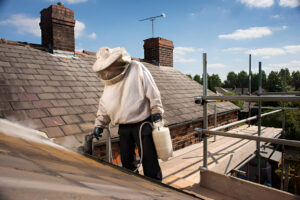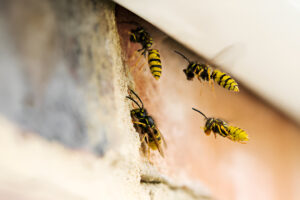Wasp & Hornet Nest Identification
Expert Removal Services in Hertfordshire
The Telltale Signs of Unwanted Guests
The Hertfordshire summer brings many delights, but unwanted wasp and hornet visitors aren’t among them. At Peskey Solutions, we specialise in identifying and safely removing these potentially dangerous nests from properties across the county. Understanding the early warning signs can help you address the problem before it becomes a serious concern.

Seasonal Patterns: When to Be on Alert
In Hertfordshire’s climate, wasp activity typically begins in mid-spring, around late April, when queen wasps emerge from their winter hibernation. Many homeowners contact us during this period mistakenly identifying solitary bees as wasps. There’s a crucial distinction—bees are beneficial pollinators requiring protection, while wasps and hornets can pose genuine risks to your household.
The queen’s initial nest-building efforts are often unsuccessful. These early-stage nests are small, papery structures that you might spot in quiet corners of outbuildings or garden structures. The survival rate at this phase is relatively low, as the solitary queen must forage, build, and defend her nascent colony simultaneously.

Colony Development: From Subtle to Obvious
By early summer, successful colonies enter a new phase. Worker wasps emerge and take over nest construction and foraging, allowing the queen to focus exclusively on egg-laying. This marks a significant turning point in colony development and when most Hertfordshire residents begin noticing increased wasp activity around their properties.
The behaviour patterns change noticeably during this transition. Early-season wasps tend to be less defensive as they’re focused on gathering resources and building the colony. By mid-summer, their numbers increase dramatically, and their protective instincts become more pronounced.
Recognition Factors: Is It a Nest or Just Passing Traffic?
Distinguishing between wasps visiting your garden to collect materials and those that have established a residence requires careful observation. Key indicators of an established nest include:
- Consistent wasp traffic following the same flight paths
- Wasps entering and exiting from the same small gap or opening
- Increased wasp sightings inside your home, particularly around windows and loft spaces
- A distinct papery structure visible in sheltered locations
- Buzzing sounds emanating from wall cavities, roof spaces, or garden structures

Common Nesting Locations in Hertfordshire Properties
The architectural features of typical Hertfordshire homes create ideal nesting opportunities for wasps and hornets. We frequently remove nests from:
- Roof soffits and fascia boards
- Loft spaces accessed through tiny entry points
- Wall cavities, particularly in older properties
- Garden sheds and detached garages
- Compost bins and garden storage areas
- Dense shrubs and hedgerows
- Children’s play equipment that remains unused for periods
Hornets, larger and more imposing than their wasp cousins, often prefer higher nesting sites and may establish colonies in tree hollows or tall garden structures.
The Dangers of DIY Removal
Attempting to remove a wasp or hornet nest without professional equipment and expertise can lead to serious consequences. Unlike solitary stinging incidents, disturbing a nest triggers a colony-wide defensive response, potentially resulting in multiple stings that can cause severe reactions even in those without known allergies.
At Peskey Solutions, our technicians arrive fully equipped with specialised protective gear and effective treatment methods that neutralise the entire colony safely. Our approach prioritises both human safety and environmental responsibility.
Professional Assessment and Treatment
Our experienced team conducts a thorough property assessment to identify all nesting sites—not just the obvious ones. Many Hertfordshire properties harbour multiple nests, particularly in larger gardens with diverse structures.
After treatment, we provide valuable preventative advice tailored to your specific property, helping to reduce the likelihood of future infestations. This might include structural recommendations, maintenance suggestions, or behavioural adjustments that make your property less attractive to nest-building queens.
Protected Species Considerations
Not all flying insects require removal. Hertfordshire is home to many beneficial pollinators, including various bee species that enjoy legal protection. Our technicians are trained to distinguish between problematic wasp and hornet colonies and beneficial insects that should be preserved or relocated rather than destroyed.
When honeybee colonies are discovered, we work with local beekeepers to arrange safe removal and relocation rather than destruction, supporting local ecology while still resolving your immediate concern.
Contact Peskey Solutions for Expert Assistance
If you’ve noticed increased wasp or hornet activity around your Hertfordshire home, don’t wait until the colony grows to potentially dangerous proportions. Contact Peskey Solutions for prompt, professional assessment and safe removal. Our local expertise ensures that your property returns to being a safe, pest-free environment with minimal disruption to your household.
